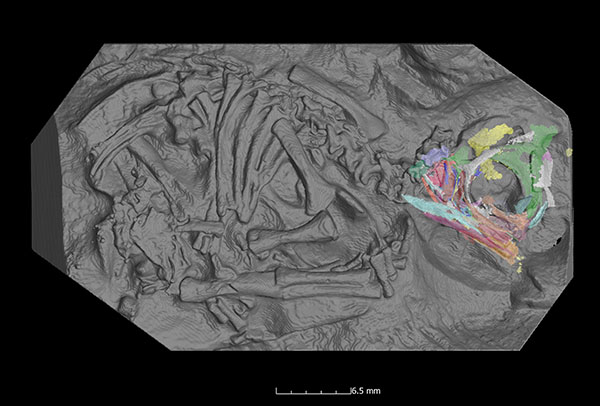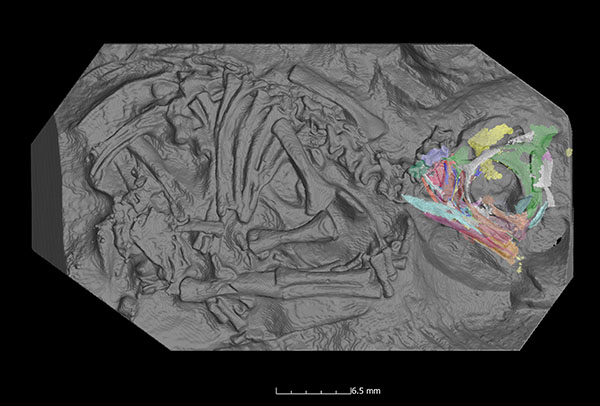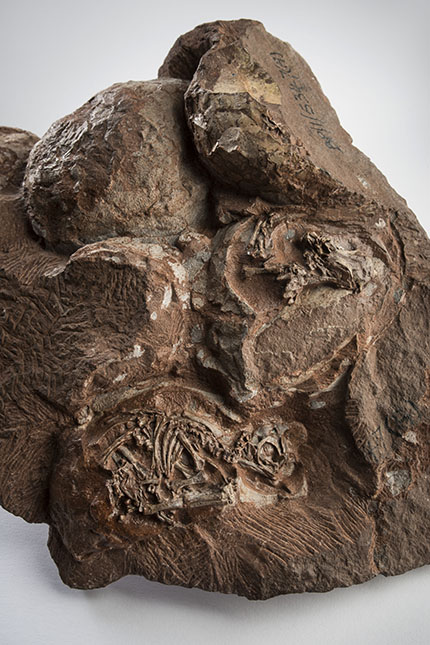DINOSAUR "EASTER EGGS" REVEAL THEIR CONTENTS IN 3D

High-powered X-rays of the world’s oldest fossilised dinosaur embryos show surprising similarities to the embryos of today’s crocodiles, lizards and chickens.
Wits palaeontologists have digitally reconstructed the skull of a 200-million-year-old baby dinosaur by using powerful x-rays to scan the fragile contents of some of the oldest dinosaur eggs ever found.
The embryos, found in 1976 in Golden Gate Highlands National Park (Free State Province, South Africa) belong to South Africa’s iconic dinosaur Massospondylus carinatus, a 5-metre long herbivore that nested in the Free State region 200 million years ago.
In the research, led by Dr Kimberley Chapelle and Professor Jonah Choiniere of the Evolutionary Studies Institute, based at Wits University, was published today in Scientific Reports. In the publication, they present 3D reconstructions of the ~2cm-long skulls of some of the world’s oldest dinosaur embryos.
 Peering inside one of the Massospondylus carinatus embryos using synchrotron scans to look at the skull bones. Picture by Dr Kimi Chapelle.
Peering inside one of the Massospondylus carinatus embryos using synchrotron scans to look at the skull bones. Picture by Dr Kimi Chapelle.
The scientific usefulness of the embryos was previously limited, due to their extremely fragile nature and tiny size. In 2015, Chapelle and Choiniere took the fossils to the European Synchrotron Radiation Facility (ESRF) in Grenoble, France, where they were scanned by Dr Vincent Fernandez, then working at the ESRF.
At the ESRF, a massive ring of electrons traveling at the speed of light emits high-powered X-ray beams that can be used to CT scan objects like fossils. The embryos were scanned at an unprecedented level of detail – at the resolution of an individual bone cell. With these data in hand, and nearly 3 years of data processing at Wits’ laboratory, Chapelle was able to reconstruct a 3D model of the baby dinosaur skull.
Up until now, it was believed that the embryos in those eggs had died just before hatching. However, during her study Chapelle noticed similarities with the developing embryos of living dinosaur relatives (crocodiles, chickens, turtles, and lizards). By comparing which bones of the skull were present at different stages of their embryonic development, Chapelle established that the Massospondylus embryos were actually much younger than previously thought – they had reached only 60% through their incubation period!
 Some of the world’s oldest known dinosaur eggs and embryos. The clutch of Massospondylus carinatus eggs discovered in 1976 in Golden Gate Highland National Park, South Africa. Picture by Brett Eloff.
Some of the world’s oldest known dinosaur eggs and embryos. The clutch of Massospondylus carinatus eggs discovered in 1976 in Golden Gate Highland National Park, South Africa. Picture by Brett Eloff.
Among their other interesting findings, Chapelle found that each embryo had two types of teeth preserved in its developing jaws. One set was made up of very simple triangular teeth that would have been resorbed or shed before hatching, just like geckos and crocodiles today. The second set was very similar to that of adults, and would be the one that the embryos hatch with.
“I was really surprised to find that these embryos not only had teeth, but had two types of teeth. The teeth are so tiny; they range from 0.4 to 0.7mm wide. That’s smaller than the tip of a toothpick!”
The research showed that dinosaurs developed in the egg just like their modern-day reptilian relatives, whose embryonic developmental pattern hasn’t changed in 200 million years.
“It is incredible that in more than 250 million years of reptile evolution, the way the skull develops in the egg remains more or less the same. Goes to show – you don’t mess with a good thing,” says Choiniere.
Chapelle and her co-authors aren’t done with the research yet! They hope to apply their method to other dinosaur embryos to estimate their level of development. They will be looking at the rest of the skeleton of the Massospondylus embryos to see if it also shares similarities in development with today’s dinosaur relatives. The arms and legs of the Massospondylus embryos have already been used to show that hatchlings likely walked on two legs.
“No lab CT scanner in the world can generate these kinds of data,” says Fernandez, “only with a huge facility like the ESRF can we unlock the hidden potential of our most exciting fossils. This research is a great example of a global collaboration between Europe and the South African National Research Foundation”